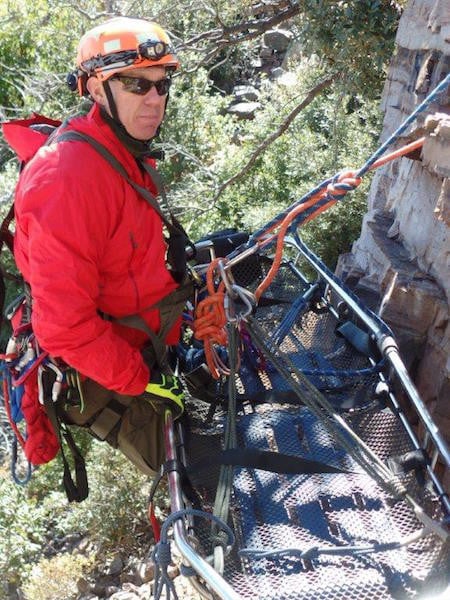Scott Schneeweis, an avid 53-year old distance swimmer, spent his entire life pushing the boundaries of agility and endurance with his body. After retiring from active duty as a Naval Officer for more than 30 years, Scott tried his hand as a technical rescue volunteer with the Cochise County Sherriff’s Department.
Although Scott was very physically fit, ate well, and was in overall good health, he started to notice random muscle twitching throughout his body. When the twitching began to impact his quality of life he decided to get it checked out.
After undergoing a cervical MRI, Scott was diagnosed with severe spinal stenosis, which is the narrowing of spaces in the spine and causes increased pressure on the spinal cord and nerves. His condition was so severe that his cervical discs were pinching on his spinal canal with the potential to cause serious permanent damage to the spinal cord; in extreme cases the condition can lead to permanent disability or paralysis.
 “I was told that I would have to have a discectomy and spinal fusion done in two adjacent levels of my cervical spine,” said Scott. Spinal fusion is essentially a process in which two cervical discs are welded together to take the joint out of service. This surgery would reduce the mobility of Scott’s neck and result in an extended recovery period, delaying full resumption of his active lifestyle and volunteer work by many months. A principle concern was his ability to return to his daily 3,000 meter swims as soon as possible.
“I was told that I would have to have a discectomy and spinal fusion done in two adjacent levels of my cervical spine,” said Scott. Spinal fusion is essentially a process in which two cervical discs are welded together to take the joint out of service. This surgery would reduce the mobility of Scott’s neck and result in an extended recovery period, delaying full resumption of his active lifestyle and volunteer work by many months. A principle concern was his ability to return to his daily 3,000 meter swims as soon as possible.
Understandably, Scott began researching to see if there were any other options out there. “I gravitated toward Barrow because of their reputation as educators and a center of excellence for neurosurgery. They are known for being on the cutting-edge of technical innovation in the field of Neurosciences and consistently achieve outstanding patient outcomes when benchmarked against other national institutions performing similar medical procedures,” said Scott.
So he contacted the Barrow Second Opinion Program, which gives patients access to Barrow neurosurgeons who offer another perspective on their medical condition. Francisco Ponce, MD, neurosurgeon was the one who took a look at Scott’s case.
“He is young and active, he looked great, but his MRI showed that his spinal cord was severely pinched,” said Dr. Ponce. “If it was my spine, I would want something done. But we wanted to make sure we kept him in the game, and so we discussed alternatives to fusion.”
When Scott showed up in Dr. Ponce’s office, he was very apprehensive. “I had never had major surgery before and I had a lot of questions,” said Scott. “It took a few visits and phone calls to convince me to go through with the surgery.”
Dr. Ponce spent an extensive amount of time with Scott, explaining all of the options available to him. Scott was pushing for a dual level arthroplasty surgery, which is where two implants are placed in between the spine discs and relieves pressure on the spinal cord. This type of surgery was not common, but allowed for greater chances for range of motion than the alternative fusion surgery.
“Dr. Ponce didn’t sugar coat anything,” said Scott. “He told me that if he could get in there and successfully implant both devices, he would.” Surgery was scheduled for the next day.
Dr. Ponce and his team went in and managed to successfully perform a dual level arthroplasty. “The first priority was to safely decompress the spine,” said Dr. Ponce. “The fact that we were able to maintain mobility by avoiding a fusion was a bonus.”
The surgery went very well with no complications. As soon as Scott was awake he was told the good news. But the firsthand experience was even more powerful. “I woke up and walked 40 laps around the hospital,” said Scott.
He was sent home the next day. And the day after that Scott went hiking with no post op pain medication other than an anti-inflammatory.
“I felt normal and had no pain. Dr. Ponce is my hero,” said Scott. “In short, I’ve experienced the best possible outcome.” At three weeks post-op, Scott was cleared to resume his distance swimming.
Today Scott is back in action as a search and rescue volunteer. “I couldn’t have done it, and may never have elected to even undergo the procedure without Dr. Ponce’s intervention and the rest of the outstanding team at Barrow.”
As a Barrow patient, you can feel confident we’ll exhaust every avenue to arrive at a proper diagnosis and treatment plan customized specifically for you. Request an appointment online and our Patient Navigator will guide you through the next steps.
Request an Appointment